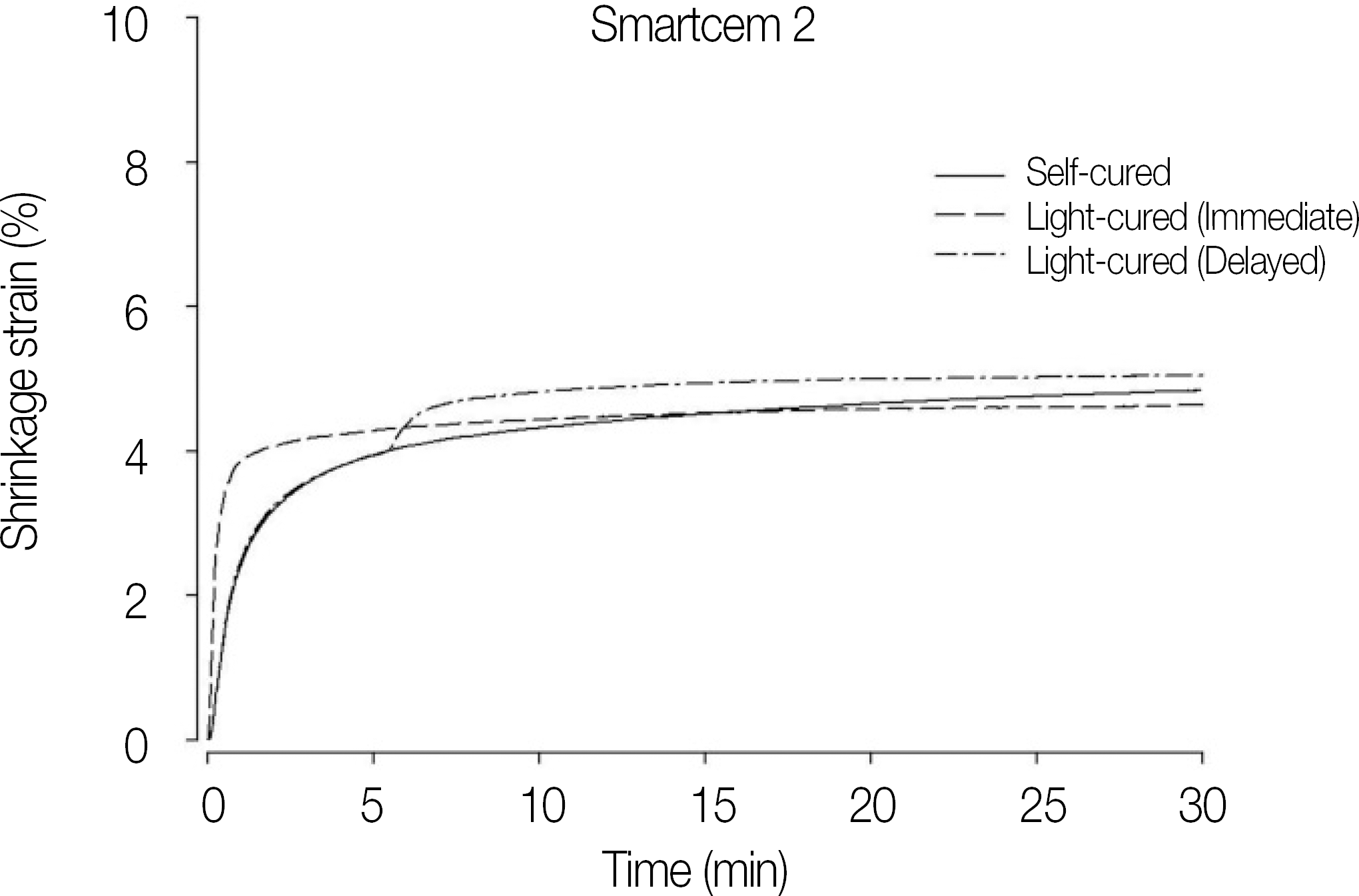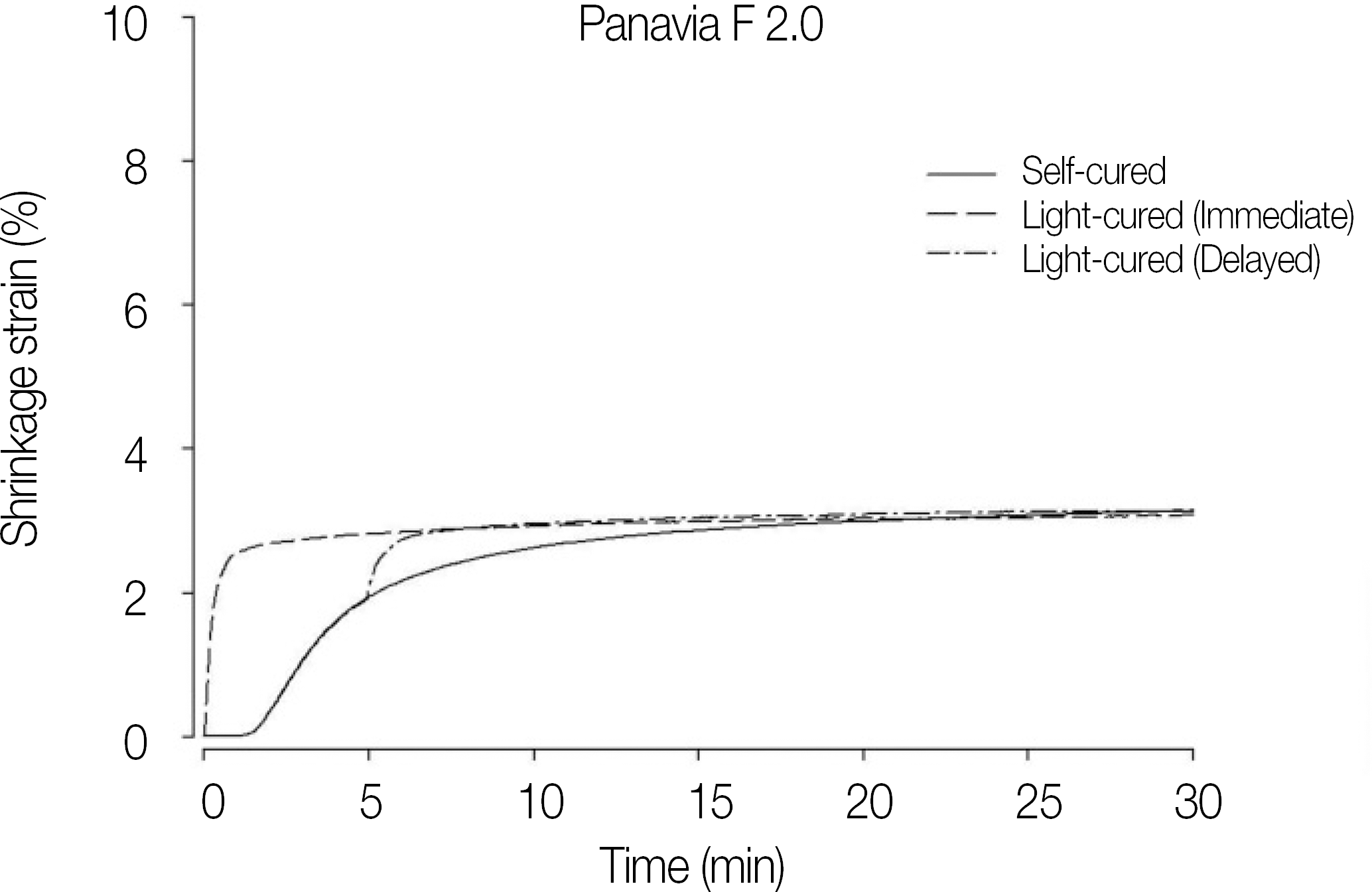Abstract
Purpose
This study was designed to compare the amount of polymerization shrinkage of dual-cure resin cements according to different polymerization modes and to determine the effect of light activation on the degree of polymerization.
Materials and methods
Four kinds of dual-cure resin cements were investigated: Smartcem 2, Panavia F 2.0, Clearfil SA Luting and Zirconite. Each material was tested in three different polymerization modes: self-polymerization only, immediate light polymerization and 5 minutes-delayed light polymerization. The time-dependent polymerization shrinkage-strain was evaluated for 30 minutes by Bonded-disk method at 37°C. Five recordings of each material with three different modes were taken. Data were analyzed using one-way ANOVA and multiple comparison Scheffe′test (α =.05).
Results
All materials, except Panavia F 2.0, exhibited the highest polymerization shrinkage-strain through delayed light-activated polymerization. No significant difference between light activation modes was found with Panavia F 2.0. All materials exhibited more than 90% of polymerization rate in the immediate or delayed light activated group within 10 minutes.
Go to : 
REFERENCES
1. Venhoven BA, de Gee AJ, Davidson CL. Light initiation of dental resins: dynamics of the polymerization. Biomaterials. 1996; 17:2313–8.

2. Braga RR, Ferracane JL. Contraction stress related to degree of conversion and reaction kinetics. J Dent Res. 2002; 81:114–8.

3. Lu H, Stansbury JW, Bowman CN. Towards the elucidation of shrinkage stress development and relaxation in dental composites. Dent Mater. 2004; 20:979–86.

4. Calheiros FC, Daronch M, Rueggeberg FA, Braga RR. Influence of irradiant energy on degree of conversion, polymerization rate and shrinkage stress in an experimental resin composite system. Dent Mater. 2008; 24:1164–8.

5. Hansel C, Leyhausen G, Mai UE, Geurtsen W. Effects of various resin composite (co)monomers and extracts on two caries-associated micro-organisms in vitro. J Dent Res. 1998; 77:60–7.

6. Arikawa H, Kanie T, Fujii K, Shinohara N. Bending strength and depth of cure of light-cured composite resins irradiated using filters that simulate enamel. J Oral Rehabil. 2004; 31:74–80.

7. Di Francescantonio M, Aguiar TR, Arrais CA, Cavalcanti AN, Davanzo CU, Giannini M. Influence of viscosity and curing mode on degree of conversion of dual-cured resin cements. Eur J Dent. 2013; 7:81–5.
8. de Menezes MJ, Arrais CA, Giannini M. Influence of light-activated and auto- and dual-polymerizing adhesive systems on bond strength of indirect composite resin to dentin. J Prosthet Dent. 2006; 96:115–21.

9. Arrais CA, Giannini M, Rueggeberg FA, Pashley DH. Microtensile bond strength of dual-polymerizing cementing systems to dentin using different polymerizing modes. J Prosthet Dent. 2007; 97:99–106.

10. Pegoraro TA, da Silva NR, Carvalho RM. Cements for use in esthetic dentistry. Dent Clin North Am. 2007; 51:453–71.

11. Atlas AM, Raman P, Dworak M, Mante F, Blatz MB. Effect of delayed light polymerization of a dual-cured composite base on microleakage of Class 2 posterior composite open-sandwich restorations. Quintessence Int. 2009; 40:471–7.
12. Moraes RR, Faria-e-Silva AL, Ogliari FA, Correr-Sobrinho L, Demarco FF, Piva E. Impact of immediate and delayed light activation on self-polymerization of dual-cured dental resin luting agents. Acta Biomater. 2009; 5:2095–100.

13. Watts DC, Cash AJ. Determination of polymerization shrinkage kinetics in visible-light-cured materials: methods development. Dent Mater. 1991; 7:281–7.

14. Watts DC, Marouf AS. Optimal specimen geometry in bonded-disk shrinkage-strain measurements on light-cured biomaterials. Dent Mater. 2000; 16:447–51.

15. Kim SH, Watts DC. Polymerization shrinkage-strain kinetics of temporary crown and bridge materials. Dent Mater. 2004; 20:88–95.

16. Spinell T, Schedle A, Watts DC. Polymerization shrinkage kinetics of dimethacrylate resin-cements. Dent Mater. 2009; 25:1058–66.

17. Moraes RR, Brandt WC, Naves LZ, Correr-Sobrinho L, Piva E. Light- and time-dependent polymerization of dual-cured resin luting agent beneath ceramic. Acta Odontol Scand. 2008; 66:257–61.

18. Kim JW, Jang KT, Lee SH, Kim CC, Hahn SH, Garc l′ a-Godoy F. Effect of curing method and curing time on the microhardness and wear of pit and fissure sealants. Dent Mater. 2002; 18:120–7.

19. el-Mowafy OM, Rubo MH, el-Badrawy WA. Hardening of new resin cements cured through a ceramic inlay. Oper Dent. 1999; 24:38–44.
20. Braga RR, Cesar PF, Gonzaga CC. Mechanical properties of resin cements with different activation modes. J Oral Rehabil. 2002; 29:257–62.

21. Blackman R, Barghi N, Duke E. Influence of ceramic thickness on the polymerization of light-cured resin cement. J Prosthet Dent. 1990; 63:295–300.

22. Arrais CA, Rueggeberg FA, Waller JL, de Goes MF, Giannini M. Effect of curing mode on the polymerization characteristics of dual-cured resin cement systems. J Dent. 2008; 36:418–26.

23. Rueggeberg FA, Caughman WF. The influence of light exposure on polymerization of dual-cure resin cements. Oper Dent. 1993; 18:48–55.
Go to : 
 | Fig. 1.Representative polymerization shrinkage-strain kinetic curves of Smartcem 2 for each curing mode. |
 | Fig. 2.Representative polymerization shrinkage-strain kinetic curves of Panavia F 2.0 for each curing mode. |
 | Fig. 3.Representative polymerization shrinkage-strain kinetic curves of Clearfil SA Luting for each curing mode. |
 | Fig. 4.Representative polymerization shrinkage-strain kinetic curves of Zirconite for each curing mode. |
 | Fig. 5.Polymerization shrinkage-strain of dual-cure resin cements investigated for different curing mode at 30 minutes. The values with the same superscript letter are not significantly different from each other based on multiple comparison Scheffe′test (P>.05). |
Table 1.
Dual-cure resin cements investigated in this study
Table 2.
Means and standard deviations in parenthesis of the polymerization shrinkage-strain of dual-cure resin cements investigated
Table 3.
Ratio of polymerization (%) at 10 minutes to 30 minutes




 PDF
PDF ePub
ePub Citation
Citation Print
Print


 XML Download
XML Download